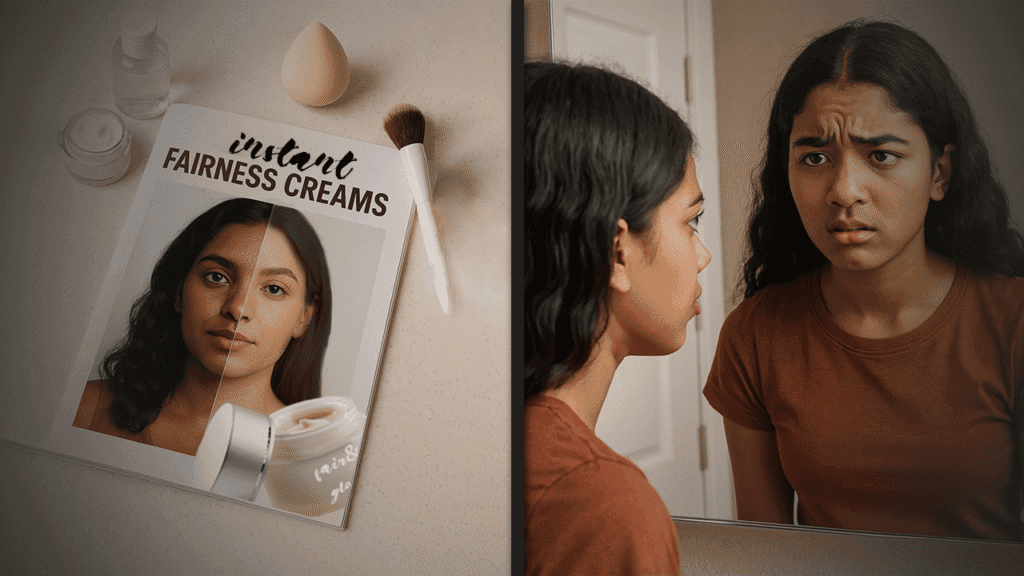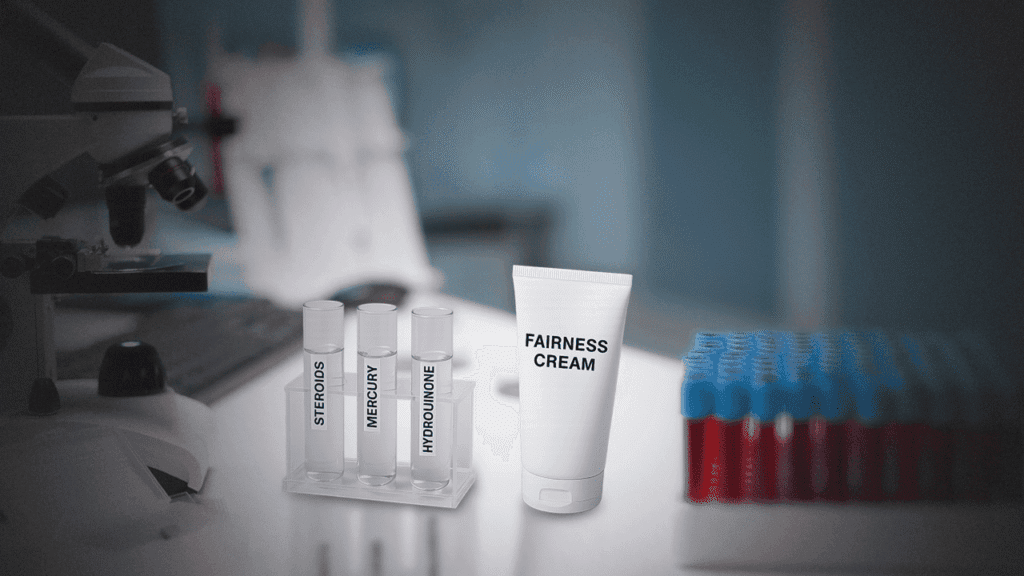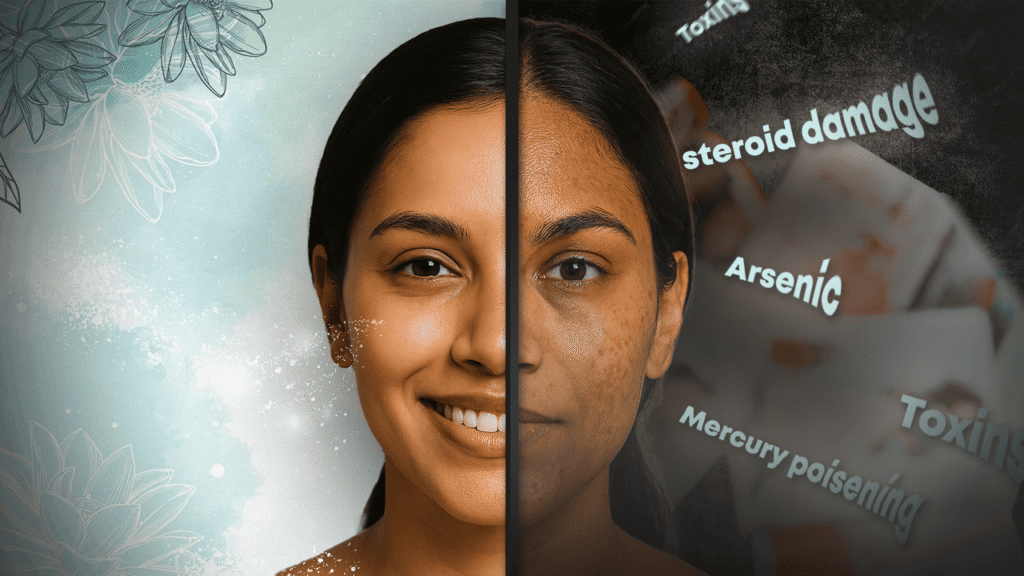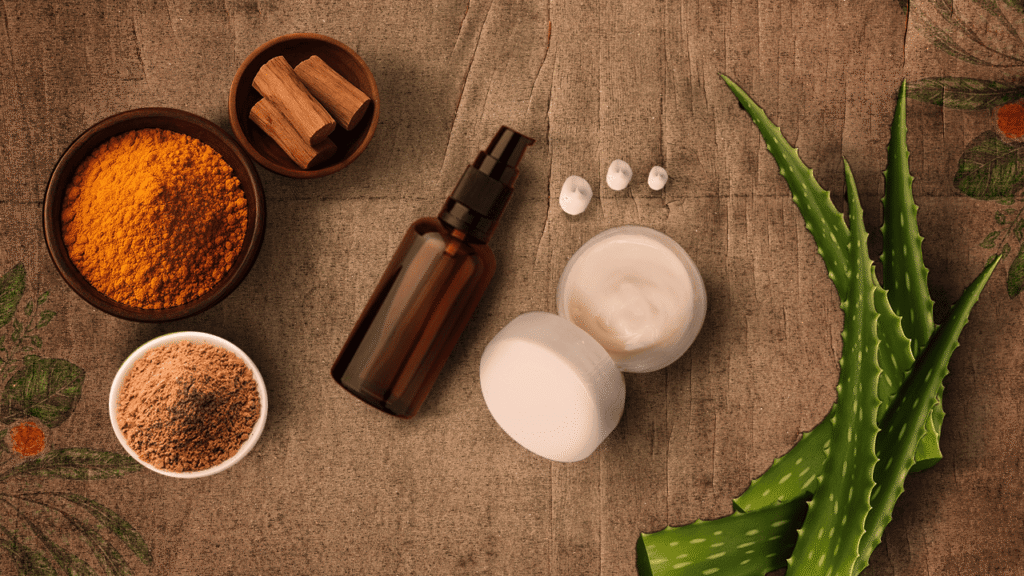Advertisement

- Updated on May 14, 2025
- IST 8:15 am
Introduction: The Fairness Trap
Imagine this: you’re flipping through a magazine, and every other ad screams, “Get fairer skin in just 7 days!” The models? Flawless, porcelain-skinned, and airbrushed to perfection. Now, look in the mirror. If you’re like millions of Indians, you might feel a pang of inadequacy. That’s the fairness cream industry working its magic—on your mind, not your skin. In a country where fair skin is often mistaken for a beauty standard, these creams have become a multi-billion rupee juggernaut. But here’s the catch: your “fair” cream is stealing your skin’s health—time to embrace melanin!
Fairness creams promise a quick fix for everything from acne scars to aging, but dermatologists are raising red flags. Behind the glossy ads lie ingredients like steroids, mercury, and hydroquinone—chemicals that can wreck your skin over time. From thinning skin to hyperpigmentation and even skin cancer risks, the damage is real. So, why do we keep falling for it? And more importantly, how can we break free? This blog dives deep into the dark side of fairness creams, exposes their harmful secrets, and offers melanin-friendly routines that celebrate your natural beauty. Ready to unlearn the fairness myth? Let’s begin.

The Fairness Cream Industry: A Billion-Rupee Mirage
India’s obsession with fair skin isn’t new—it’s a legacy of colonialism, where lighter skin was linked to power and privilege. Fast forward to 2025, and the fairness cream market is booming, projected to hit ₹10,000 crore by 2026, per a Business Today report. Brands like Fair & Lovely (now Glow & Lovely), Pond’s White Beauty, and Garnier White Complete dominate shelves, promising miracles in a tube. But it’s not just women—men’s fairness creams are a growing niche, with ads featuring Bollywood hunks like Shah Rukh Khan and John Abraham.
The marketing is relentless: “Get noticed,” “Boost your confidence,” “Land that dream job.” It’s psychological warfare, preying on insecurities. A 2023 study by the Indian Journal of Social Psychiatry found that 62% of young Indians felt pressured to lighten their skin for social acceptance. But here’s the irony: these creams don’t make you fairer—they just mask the problem, often making it worse. Dr. Anjali Shah, a Mumbai-based dermatologist, puts it bluntly: “Fairness creams are like putting a band-aid on a fracture. They cover up, but they don’t heal.”

Harmful Ingredients: What’s Really in Your Cream?
Fairness creams aren’t magic potions—they’re chemical cocktails. Let’s unmask the villains:
- Steroids: These are the heavy hitters. Used to reduce inflammation, steroids in creams can thin your skin over time, making it fragile and prone to tears. “It’s like turning your skin into tissue paper,” says Dr. Shah. Worse, steroids can cause steroid acne—ironic, right?—and make your skin hypersensitive to sunlight.
- Mercury: This toxic metal is banned in many countries but still sneaks into some Indian creams. Mercury blocks melanin production, lightening skin temporarily, but at a steep cost: kidney damage, nerve issues, and mercury poisoning. A 2024 raid by the FDA found mercury in 15% of fairness creams sold in Mumbai’s markets.
- Hydroquinone: Dubbed the “skin bleach,” hydroquinone fades dark spots but can backfire, causing ochronosis—a condition where skin turns bluish-black. “It’s like trading one problem for another,” warns Dr. Rajesh Verma, a Delhi dermatologist.
- Parabens and Fragrances: These preservatives and scents can irritate sensitive skin, leading to rashes or allergies.
A 2023 study by the Indian Dermatology Association tested 50 popular fairness creams: 30% contained steroids, 10% had mercury above safe limits, and 20% had hydroquinone. Shocking? Yes. Surprising? Not really. The industry thrives on lax regulations and consumer desperation.

The Damage Done: Long-Term Skin Sabotage
Slathering on fairness creams might feel harmless at first, but the damage creeps up. Here’s what dermatologists see in their clinics:
- Thinning Skin: Steroids break down collagen, the protein that keeps skin plump. Over time, your skin becomes crepey and bruise-prone. “I’ve seen patients whose skin tears from a simple scratch,” says Dr. Verma.
- Hyperpigmentation: Ironically, the quest for fairness can lead to dark patches. Mercury and hydroquinone disrupt melanin, causing uneven skin tone. A 2024 Journal of Clinical Dermatology study found that 25% of long-term fairness cream users developed paradoxical darkening.
- Acne and Rosacea: Steroids can trigger steroid acne—clusters of small, itchy bumps. They also dilate blood vessels, leading to rosacea-like redness.
- Skin Cancer Risks: Weakened skin is a playground for UV damage. “Thinned skin absorbs more UV rays, raising the risk of skin cancer,” explains Dr. Shah. A 2023 Indian Cancer Research report linked prolonged steroid cream use to a 15% higher risk of basal cell carcinoma.
And it’s not just physical. The emotional toll is brutal. “Patients come in devastated,” says Dr. Verma. “They wanted to look better but ended up with skin they barely recognize.”

The Fairness Myth: Unpacking India’s Colorism
Why are we so fixated on fair skin? It’s a tangled web of history, media, and societal norms. During British rule, fair skin was associated with the elite, while darker skin was linked to laborers. Post-independence, Bollywood and TV ads kept the bias alive. “Fairness is often equated with success, beauty, and even morality,” says sociologist Dr. Meera Rao. “It’s a colonial hangover we can’t seem to shake.”
Matrimonial ads bluntly state “fair bride wanted,” and job ads subtly prefer “fair-complexioned” candidates. A 2024 Times of India survey found 58% of respondents believed fair skin improved job prospects. It’s a self-fulfilling prophecy: people use fairness creams to fit in, perpetuating the cycle.
But here’s the truth: skin color doesn’t define worth. Melanin-rich skin is naturally resilient, with built-in UV protection. “Darker skin has more eumelanin, which guards against sun damage,” explains Dr. Shah. “It’s a biological gift, not a flaw.”
Cultural Shift:
Thankfully, tides are turning. Celebs like Nandita Das and Radhika Apte champion dark skin pride, and campaigns like “Dark is Beautiful” challenge norms. “We’re slowly unlearning colorism,” says Dr. Rao, “but it’s a long road.”
Breaking Free: Melanin-Friendly Skincare Routines
So, how do you ditch the fairness chase and embrace your skin? It’s simpler than you think. Focus on health, not color. Here’s a dermatologist-approved routine:
- Cleanse Gently: Use a sulfate-free cleanser to remove dirt without stripping moisture. Try Cetaphil or Himalaya Neem Face Wash.
- Exfoliate Weekly: Slough off dead cells with a mild scrub or a DIY mix of oatmeal and honey. Over-exfoliating? Big no.
- Serum Power: Apply a vitamin C or niacinamide serum to brighten naturally and even out tone.
- Moisturize Right: Pick a non-comedogenic moisturizer—light for oily skin, richer for dry. Look for “oil-free” or “water-based.”
- Sunscreen Daily: UV rays darken existing spots. Use SPF 30+ like Neutrogena Ultra Sheer or Lakmé Sun Expert.
Pro Tip:
Patch-test new products on your wrist to avoid reactions. “Indian skin can be sensitive,” notes Dr. Verma. “Go slow.”
Ayurvedic Glow-Up:
Ayurveda offers time-tested fixes:
- Turmeric Mask: Mix turmeric and yogurt for a 10-minute glow booster. “Turmeric’s curcumin reduces inflammation,” says Ayurvedic expert Dr. Priya Nair.
- Aloe Vera Gel: Fresh from the plant or bottled, it hydrates and heals.
- Sandalwood Paste: Cools and brightens—perfect for summer.
“Natural remedies complement modern skincare,” adds Dr. Nair. “Just don’t expect overnight miracles.”

The Emotional Toll: Loving the Skin You’re In
Let’s talk real: damaged skin hurts more than your appearance—it hits your self-esteem. “I avoided mirrors,” says Priya, 24, who battled steroid-induced rosacea. “It felt like my skin betrayed me.” If this resonates, you’re not alone. A 2023 Indian Mental Health Journal study found 40% of chronic acne or pigmentation patients faced anxiety or depression.
Breaking free starts with self-compassion. “Your skin doesn’t define you,” says therapist Ananya Desai. “It’s a part of you, but not all of you.” Try these:
- Affirmations: Stand in front of the mirror and say, “I am beautiful as I am.” Cheesy? Maybe. Effective? Yes.
- Unfollow Triggers: If fairness ads or “perfect” Insta feeds drag you down, mute them.
- Seek Support: Talk to friends or a counselor if skin woes weigh on your mind.
“Confidence is the best cosmetic,” Desai adds. “Wear it daily.”
When to See a Dermatologist
If your skin’s in distress—think persistent rashes, darkening, or thinning—don’t DIY it. “Fairness cream damage can be reversed, but it takes expertise,” says Dr. Shah. Treatments like chemical peels, laser therapy, or prescription creams can help. And if mercury exposure is suspected, get a blood test stat.
“Early intervention saves your skin,” Dr. Verma emphasizes. “Don’t wait till it’s too late.”
Conclusion: Your Skin, Your Rules
Fairness creams sell a lie: that your natural skin isn’t good enough. But here’s the truth—you’re already worthy. Melanin isn’t a mistake; it’s a masterpiece. So, toss that tube, embrace your glow, and let your skin breathe. It’s time to rewrite the beauty script, one melanin-friendly choice at a time.
You May Like This
Advertisement

You May Like This








Advertisement

Advertisement

Advertisement


